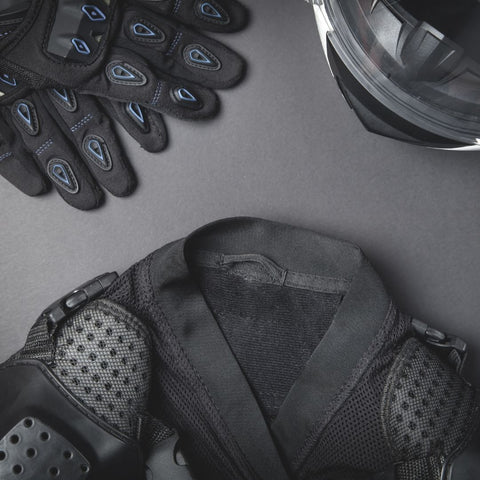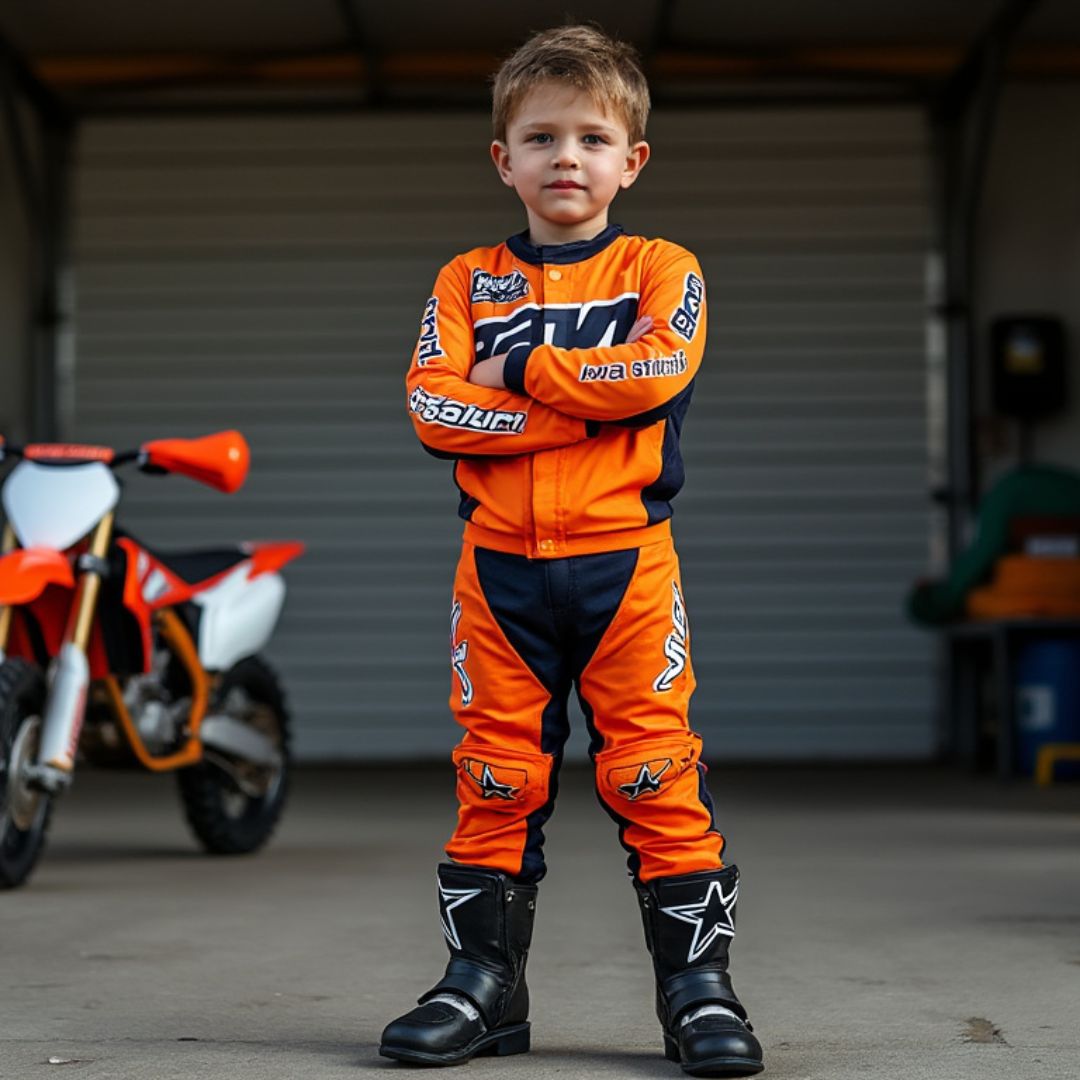
If you're like me, the thought of your kid's zipping around on a motorbike can send you a mix of excitement and worry.
It's like, on the one hand, you've got this little daredevil who's eager to explore the world on two wheels, and on the other, there's the big, protective bubble you wish you could keep them in.
So, let's talk about how we can let our young riders enjoy the thrill of biking while ensuring they stay as safe as possible.
1. Neglecting Protective Gear
The Armour They Need
First things first, gear up!
I can't stress enough how crucial it is to deck your kids out in the right protective gear.
We're talking helmets, gloves, jackets, pants, and boots—the whole nine yards.
Each piece has its role in shielding them from the bumps and scrapes that come with the territory.
It's like sending your knight into battle with the best armour you can find.
Shopping Tips
When you're shopping for gear, don't just grab the first set of pads you see.
Look for stuff that's specifically designed for kids, with the right fit, materials, and safety ratings.
A helmet that's too big or boots that are too small is more of a hazard than a help.
Related: How to Choose the Right Protective Gear for Kids' Outdoor Riding Adventures
2. Riding Their Bike on a Public Road
The Right Place to Ride
Here's where things get a bit tricky. Riding on public roads can be a minefield for young bikers.
Between navigating traffic and avoiding road hazards, it's a lot for a kid to handle.
That's why finding safe, appropriate places for them to ride is key.
Think closed circuits, private tracks, or any controlled environment far from the chaos of public streets.
Choosing the Right Off-road Track
The Quest for the Perfect Track
Now, when we talk about moving beyond the backyard and into the big, exciting world of off-road tracks, the key is finding the right spot.
It's like picking the perfect playground for your little adventurer.
You want somewhere that's just challenging enough to push their skills, but not so tough that it knocks their confidence.
Safety First, Fun Second
Look for tracks that are known for being well-maintained, with clear signage and defined paths.
These places often have staff around who know a thing or two about helping kids get the most out of their riding experience, safely.
It's also a great opportunity to meet other riding enthusiasts and maybe even find a riding buddy or mentor for your young rider.
3. Riding Beyond Skill Level
Keeping Ego in Check
It's natural for kids to think they're invincible, especially when they're on a bike. But overconfidence can lead to trouble.
Help them understand their limits and the importance of taking things one step at a time.
Riding safely is all about knowing your skills and gradually pushing the envelope, not leaping over it.
Skill Building
Look out for signs that they're ready to level up their riding, and consider enrolling them in courses that match their growing abilities.
Remember, there's always something new to learn, and mastering those skills can make riding a whole lot safer and more fun.
4. Attempting Stunts or Risky Maneuvers
The Thrill vs. The Risk
We've all seen those cool bike stunts in movies, but trying to replicate them in real life? It's not such a great idea, especially for kids.
The risk of injury just isn't worth it. Instead, steer them towards safer ways to get their adrenaline fix, like organised riding events designed for young enthusiasts.
Safe and Fun Alternatives
There's a whole world of motorbike-related activities that are exciting and challenging without being downright dangerous.
Encourage exploration of these avenues. It's all about balancing fun with safety.
5. Riding Without Proper Training
The Foundation of Safe Riding
I cannot overemphasise the importance of proper training. It's like learning to swim before diving into the deep end.
Enrolling your child in a certified motorcycle safety course is one of the best decisions you can make for their riding future.
These courses teach the fundamentals, from handling the bike to recognising and avoiding hazards.
Recognising When Your Child Is Ready for More Advanced Riding
Spotting the Signs
Growth in skills and confidence can sometimes creep up on you. One day, they're cautiously rolling around the driveway, and the next, they're asking when they can jump a ramp.
Keep an eye out for consistent control, improved balance, and a keen understanding of their bike's mechanics.
When they start asking questions that show a deeper interest in techniques and safety, that's a green flag.
Graduating to the Next Level
Once you see these signs, consider introducing more complex riding environments or even advanced courses.
Remember, the goal is to challenge them, not overwhelm them.
So, take it one step at a time, and always prioritise safety and fun.
Never Stop Learning
And the learning shouldn't stop there. Encourage your child to take advanced courses as they grow and improve.
It is invaluable to keep their skills sharp and their safety knowledge up to date.
Encouraging a Safety-First Mindset
Making Safety Cool
Instilling a safety-first mindset doesn't have to be a lecture. Make it part of your riding culture at home.
Show excitement over new gear, share stories of professional riders who prioritise safety, and celebrate safe riding milestones.
It's all about embedding the idea that safety and cool riding go hand-in-hand.
Interactive Learning
Incorporate safety lessons into everyday moments.
For instance, while watching motorbike races together, discuss the safety gear the professionals wear and the precautions they take.
It's a way to subtly reinforce the importance of safety without turning it into a serious sit-down conversation.
The Role of Parental Involvement in Riding Activities
Be Their Riding Buddy
Jumping into the world of motorbiking with your child not only strengthens your bond but also gives you firsthand insight into their skills and confidence levels.
Whether it's taking a basic course together or riding side by side on a family-friendly track, these shared experiences can be both educational and incredibly fun.
Active Support
Your involvement goes beyond just being present. It's about actively supporting their journey.
Attend their training sessions, be there for their first ride on a new track, and celebrate their progress.
Your encouragement means the world to them and reinforces the value you place on their interests and safety.
Conclusion
Wrapping up, the road to safe motorbiking for our kids is paved with good gear, appropriate riding environments, knowledge of their limits, avoiding unnecessary risks, and continuous education.
Sharing a success story, my neighbour's kid, who strictly followed these guidelines, has enjoyed years of safe riding and has grown into a responsible and skilled biker.
It goes to show the impact of diligent safety practices.
FAQs
What age is appropriate for a child to start learning to ride a motorbike?
Determining the right age for a child to start motorbike riding depends on several factors, including the child's physical coordination, maturity, and interest. Generally, kids can begin with ride-on toys or mini motorbikes as early as 3 to 6 years old under close supervision. However, for more serious riding, especially on motorbikes that require more skill and strength, waiting until they are at least 7 to 10 years old is advisable. This is also the age range where they can start understanding and respecting the importance of safety measures. Always consider the child's individual readiness and start with a motorbike that is appropriate for their size and skill level.
How can I ensure the motorbike is the right size for my child?
The right size motorbike for your child should allow them to comfortably reach the ground with both feet when sitting on the seat, ensuring stability when stationary. They should also be able to reach and operate all the controls easily. A motorbike that is too large will be difficult for them to control and could be dangerous, while a motorbike that is too small can be uncomfortable and limit their ability to learn effectively. When in doubt, consult with a professional or refer to sizing charts provided by motorbike manufacturers, which are often based on the rider's age, height, and experience level.
How do I talk to my child about motorcycle safety without scaring them?
Discussing motorcycle safety is crucial, but it's important to approach the topic in a positive and empowering way. Instead of focusing on the dangers of motorcycling, emphasise the joy and freedom it brings when done safely. Use positive reinforcement to celebrate safe riding practices, such as wearing protective gear or completing a safety course. Share stories of professional riders who are also advocates for safety to show that even the most skilled riders prioritise it. Lastly, involve them in the learning process, whether it's through choosing their gear, attending safety courses together, or practicing safe riding techniques. This approach helps build a safety-first mindset that feels natural rather than imposed.
Get in Touch 🚀
Loved our article on “5 Things Your Kids Should NEVER do on a Motorbike” Got the itch to dive into more wheely-awesome info?
Whether you're a parent or a grandparent, we're here for all your kids ride-on toy questions! 🚗💨
Feeling click-happy?
Jump straight into our wonderland at RiiRoo.com.
Or, if you're more the chatty type, give our Live Chat a whirl and let's talk toys!










Share:
Here's Why Dirt Bike Helmets Are Different to Regular Helmets
5 Things Your Kids Should NEVER do on a Quad Bike